
A Week in Samoa
I’m escaping the New Zealand winter! I knew I wanted to visit some Pacific Islands while I’m on this side of the world and winter seemed like the perfect time of year for it. This is my first time leaving New Zealand since I arrived, and my first longer holiday from work in as many months. I chose to spend my week in Samoa, joining a small group tour adventure. The trip would take us around the highlights of both the main islands, Upolu and Savai’i. Aside from some broad awareness of Polynesian culture (including what I learned in Hawaii), I didn’t know much about Samoa so I was excited to learn about somewhere new. And to get some sunshine and relaxation for a week!

Day One – Apia
I arrived in Samoa a day prior to the tour starting, landing late at night. The airport is about a 30-40 minute journey from the capital city, Apia, so I’d booked a transfer with the hotel. Then went to bed as soon as I checked in! I had the whole of the next day free until our evening welcome meeting. Since we would be visiting a lot of Apia’s main sights tomorrow, I checked to see what we wouldn’t be going to, to avoid doubling up. However, it was also a Sunday and Samoa is a very religious, Christian country, so nearly everything is closed for the day, limiting my options.
Robert Louis Stevenson’s Tomb
In the end, I decided to hike up to Robert Louis Stevenson’s tomb on Mount Vaea, which is free and accessible every day of the week. Technically, the trail starts in the Botanic Gardens, which are closed, but if you follow the road further, you’ll find a dirt track around the edge of the gardens that meets the trail. It was only a 20-minute walk from my hotel, though I had to walk on the grass beside the road, as there are no pavements.
This was an important site for me, because Stevenson was a Scottish author, who wrote Treasure Island and Jekyll & Hyde. As a former literature student and Edinburgh tour guide, I’m super interested in literary historical figures and sites. I used to talk about Stevenson on my walking tour, outside the Writer’s Museum, which has some of his belongings. And I’ve told thousands of tourists about how he moved to Samoa and is buried here. So to finally be here, on the other side of the world, was pretty incredible!
I took the “short route”, which is a very steep uphill trek, with a lot of stairs. It’s in the cover of the jungle, which offered shade from the sun. But there was no wind, so it got very humid, and I got plenty of bug bites despite applying spray. I had to take plenty breaks, and was exhausted and sweaty when I reached the top! You only get a little bit of a view but of course, the tomb is the main sight. A long, white slab of marble, where both Stevenson and his wife lie. There’s a poem about Stevenson on the sides, once in English and once in Samoan. I lingered for a while, resting on the bench, before descending the same way again.



Rest Time
By the time I got back to the hotel, I was even hotter and sweatier, so I retreated to the air conditioning of my room. I’d planned to walk downhill into the town next to look around, even if things were closed. But I was so tired and overheated from the hike. We had a busy week ahead of us too, so I ended up staying at the hotel to relax instead. I took a nap, read a book, and then headed down to the small pool, which I actually got entirely to myself for a little while. Then I got ready for the tour welcome meeting, where I met our guide, driver and the rest of the group. We got complementary cocktails and snacks as well, of which there were enough of to serve as our dinner!
Day Two – Apia
Bahá’í House of Worship
The first proper tour day of my week in Samoa was focused on sights around Apia itself, before we hit the road tomorrow. Our tour leader had made a few changes to our itinerary, removing Papase’ea Sliding Rocks due to lack of rainfall and Palolo Deep Marine Reserve, as she’d had feedback that the coral and marine life weren’t in great shape. This was definitely an adventure-style trip, where things could always change, so it’s best to go with the flow and not get too fixated on these sorts of things!
We headed uphill from the hotel, in the van, to our first stop, the Bahá’í House of Worship. The building is set in a beautiful garden, green and lush and filled with bright flowers. Actually, Samoa as a whole was very lush with plant life! We stopped in the information centre first to read the signs about the Bahá’í faith, a religion that believes in the unity of all religions and people. It was very interesting to learn about such a peaceful, respectful perspective. The house of worship looks like a large, white flower from the outside. Inside, it’s bright and airy, a nonagan shape lined with wooden pews and balconies. Interestingly, there are no sermons or ceremonies given here; only religious scriptures, from any faith, can be read aloud. It’s open for anyone to visit, and we were the only ones there, making for a peaceful visit.
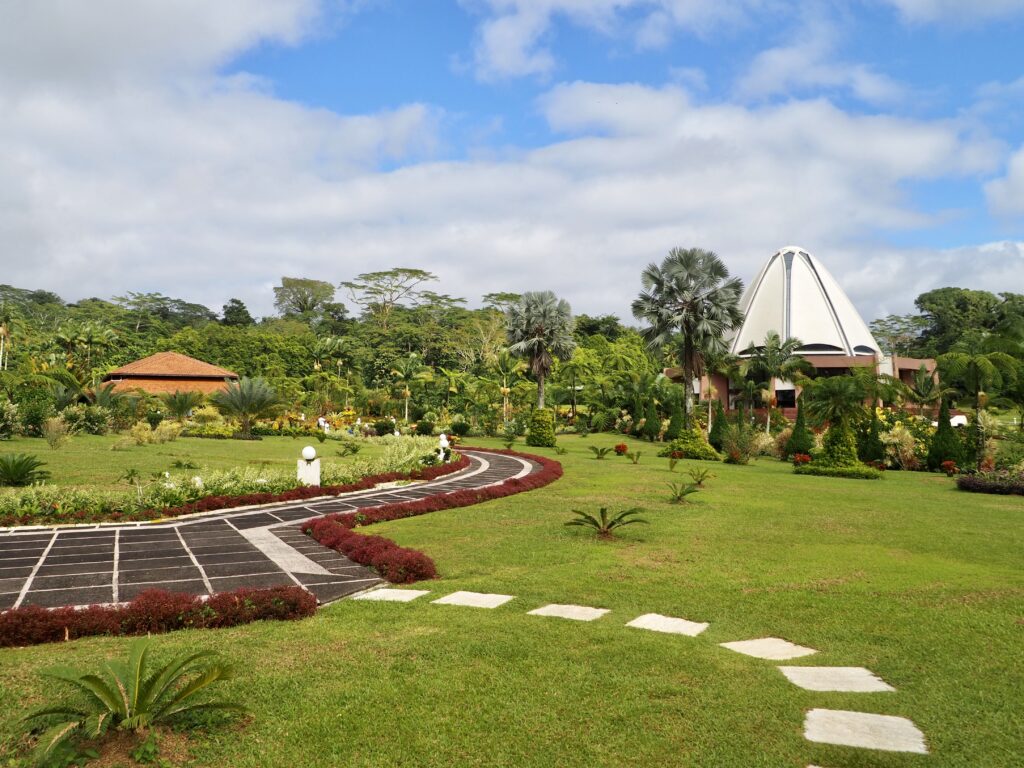


Robert Louis Stevenson Museum
Next up, the house that Robert Louis Stevenson built and lived in, and which is now a museum dedicated to his life in Samoa. After visiting his tomb yesterday, the museum was high on my bucket list for this trip! It’s a guided tour, during which we slowly made our way through each room of the house. Our guide told us what each room was used for, as well as stories of Stevenson and his family who lived here with him. He moved to Samoa for the climate, to help his tuberculosis, but he was still very sick and died in his forties.
It was interesting to hear how the family integrated with the local people as well, including Stevenson and his stepson both learning the language. Although, the fireplaces – the first ones built in Samoa, and only ever used once! – were definitely more reminders of Scotland! The museum has many photographs on the walls, giving more insight into their lives here. The way the guide spoke of Stevenson suggested that Samoans were, and still are, very fond of him and respected him greatly as a storyteller. It all made my literary history nerd side very happy!





Pacific Jewell
Our next stop was Pacific Jewell, a family-run cafe, shop and fabric printing workshop all rolled into one. We spent some time browsing the shop on arrival, which is filled with clothes, jewellery, homeware and other souvenirs, all locally crafted. I picked up my first pair of earrings on the trip here, a wooden pair carved into a Samoan symbol. Much of the clothing is printed in the workshop, including many lavalavas to choose from. These are the traditional Samoan article of clothing, worn wrapped around the waist, by both men and women.
The owner, Vivienne, met us to take us back into the workshop for a tour. She only offers these by appointment, which our leader had arranged in advance! The fabrics are called elei, printed using stencils cut from wood or old X-ray papers. She has a team of men, trained at the local art school, hand-printing her designs, many of which are exclusive commissions. It was all very impressive to see! Then we returned to the Garden Cafe out the back for our lunch. The space is absolutely full of plants, a lush canopy all around us, making for a beautiful dining spot!
Fugalei Market
Heading into Apia town centre, we drove past the waterfront and the cathedral. We didn’t spend much time exploring the town really, so this drive was our main glimpse at it. Our leader pointed out the main sights though, including government buildings and university buildings. We stopped at Fugalei market, a large fresh produce and handicraft market. Here, we had some free time to explore and shop at the many stalls.
It’s pretty cool seeing some of the produce, as there are a lot of things specific to this part of the world that I wouldn’t find back in Europe often. Our leader bought a few things for us to share and try as well. The handicrafts had a lot of standard souvenir items, like magnets, jewellery, ornaments and T-shirts. There were also a lot of lavalavas and hand fans made of dried, woven leaves, which were more unique to Samoa. I try not to buy too much stuff while I’m travelling, especially since I’m travelling light all year. Since I already got my magnet at the RLS Museum and earrings at Pacific Jewell, I restrained myself at the market!

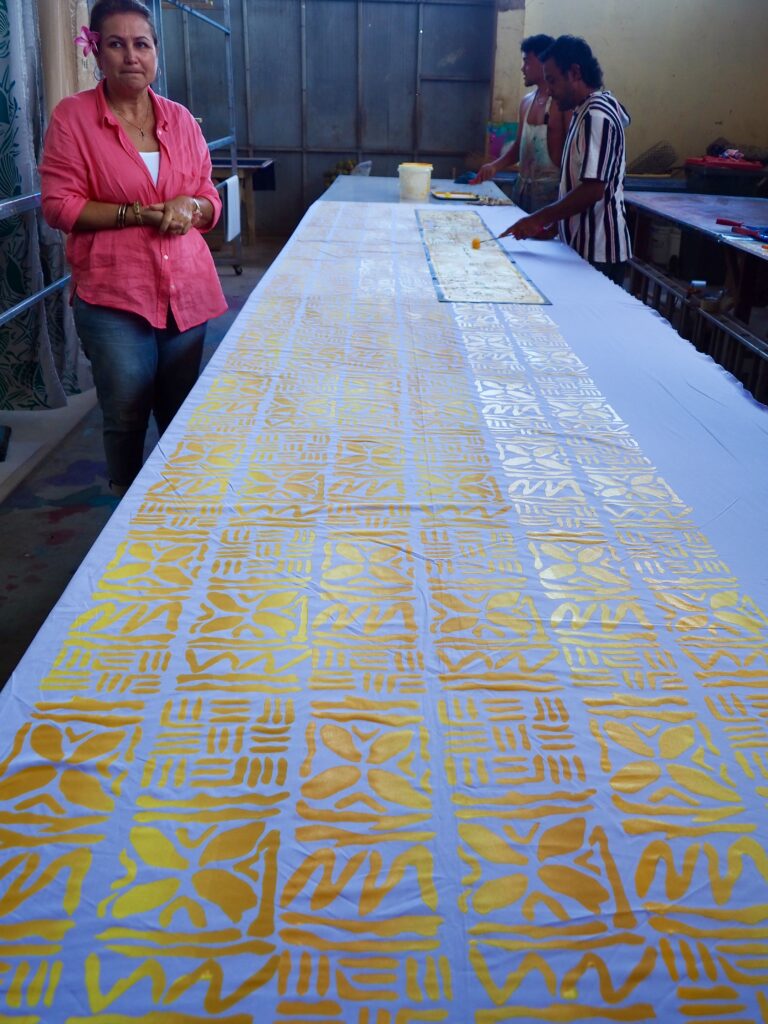


Piula Cave Pool
Our last stop of the day was actually a 20-minute drive along the coast from Apia. This was our swimming spot, since we weren’t going to the sliding rocks or marine reserve. The pool sits underneath a church, which is a pretty unusual location! We had to drive through the church grounds and pay our entrance to a staff member floating around, before driving down the ramp to the pool. It’s next to the coast, so we had sweeping ocean views along the rocky shore. From the shore, you could turn around and see the church overlooking the pool.
The pool is entirely natural, so you have to climb down the rocks to get in, being careful of your feet and hands. Half of the pool is outside, then you can swim into the cave. Our leader asked us not to try to swim out the other side, and it was too dark and narrow for me anyway! The cave was cooler than outside, which would be a welcome relief on a hot day I imagine. But the outdoor area was in the shade, so it didn’t make as much of a difference to us. I explored the cave then lounged in the outside pool for a while, until I started to get chilly. Every single place we stopped to swim in the whole trip (no matter how remote!) had some sort of changing room, which was handy!
We then headed back to Apia, where our guide dropped us off at the hotel for the night. A few of us went to dinner together at a restaurant she suggested, KokoBanana, a short walk from the hotel (not in the town centre). Then it was an early night for us all, ahead of tomorrow’s big travel day.



Day Three – Savai’i South Coast
Ferry Crossing
Today we were leaving Upolu and crossing to Samoa’s largest (though less populated) island, Savai’i. The ferry port is at the western end of Upolu, past the airport, so we had a 50-minute or so drive there from Apia. We were booked on the 8am ferry, which meant a 6am departure from the hotel. The ferries fill up, so we had to be there early. We were also supposed to have business class seats on the big ferry, but it was out of commission for repairs. The smaller, substitute vessel, doesn’t have different classes available! Once we arrived at the port, there was time for coffee and breakfast, before boarding.
The cars get packed in tight, so sometimes it’s not possible to get in and out the vehicle during the trip. Most of us opted to be out in the fresh air. And I do mean the fresh air, as there was limited indoor seating – we ended up perched on some round towers on one of the upper decks at the rear of the vessel. The smaller ships take longer to cross as well, just over an hour and a half (compared to an hour for the big one). I was chatting with some other group members throughout, but it did get a little tedious after a while. We could see both islands, in front and behind, but it seemed to take forever to get close to Savai’i! The water is a little bumpy too, causing seasickness for a few people.
Salelologa Market
Once we arrived in Savai’i, we had to drive all the way across the island to our hotel in Vaisala. Today we’d be driving the south coast, then we’d return via the north coast in a couple of days. Our first stop was just a couple of minutes from the ferry though, at Salelologa market. It was pretty similar to the Apia market, a combination of produce and handicrafts. The locals were super friendly too, lots of smiles and greetings and asking us where we were from – but not being pushy about getting us to buy anything! I decided to get another pair of earrings this time, made of coconut and with a traditional design painted on.
After leaving Salelologa, we also made a quick stop at Florence’s Place. This is a homestay-style accommodation, but we were just here to collect our packed lunches. The couple who run it also have a farm, so she had prepared beef stir fry (or veggie for the non-meat eaters), for a truly local meal! It was definitely nice to be supporting a small, local business like this.




Afu Aau Waterfall
Continuing on, we stopped at the Afu Aau waterfall next. The drive is a bumpy, gravel road, that involved some very tight steering for our driver! We paid our entrance fee, which all goes back to the local village and helps them maintain the area, like building the changing rooms and toilets. Then we walked up the river, past a few smaller falls, to reach the main waterfall and its plunge pool. With a lush jungle canopy overhead and no one here but us, it truly felt like we’d stumbled on some secluded paradise. Climbing down the slippery steps and then navigating the stony floor was a bit tricky, but once you were in the water, it was idyllic!
There are very small waterfalls around one edge of the pool, opposite the main one, and interestingly, their water was warm! Much of the pool was in the shade, so these were a lovely option to warm up if you were getting cold. The main waterfall was pretty big and heavy, so I didn’t get too close to it, but it was lovely to look at and listen to while drifting through the water. We swam and floated and lounged on rocks around the edges, lingering for as long as we had time for. Once we finally got out, we tucked into our lunches at one of the picnic tables, before hitting the road again.



Alofa’aga Blowhole
We followed the south coast, passing through villages full of colourful houses and fales (traditional houses with no walls and a domed roof). The landscape was all thick, lush jungle and a rugged coastline out here in the middle of the Pacific. We left the main road, paid another entrance fee at a small hut, then headed onto a rough, gravel track. The coast on our left was wild, with huge waves crashing against black, volcanic rocks. We drove past some locals building new beach fales, before pulling in to park by the blowhole.
Blowholes are when a hole has been naturally eroded through the coastal rock, allowing water to get up through it when the tide is high. I was supposed to see one in Hawaii but the waves weren’t right that day, so I was glad for a second opportunity here. And it didn’t disappoint! The coastline itself was already spectacular with walls of white spray all along the rocks as the waves hurtled into them. Then when the blowhole went off, it was a towering fountain of foam shooting overhead. And it was so loud! There was a line painted on the rocks that we had to stay behind, but even from a distance, we were all drenched in salty spray. It was so dramatic and impressive!


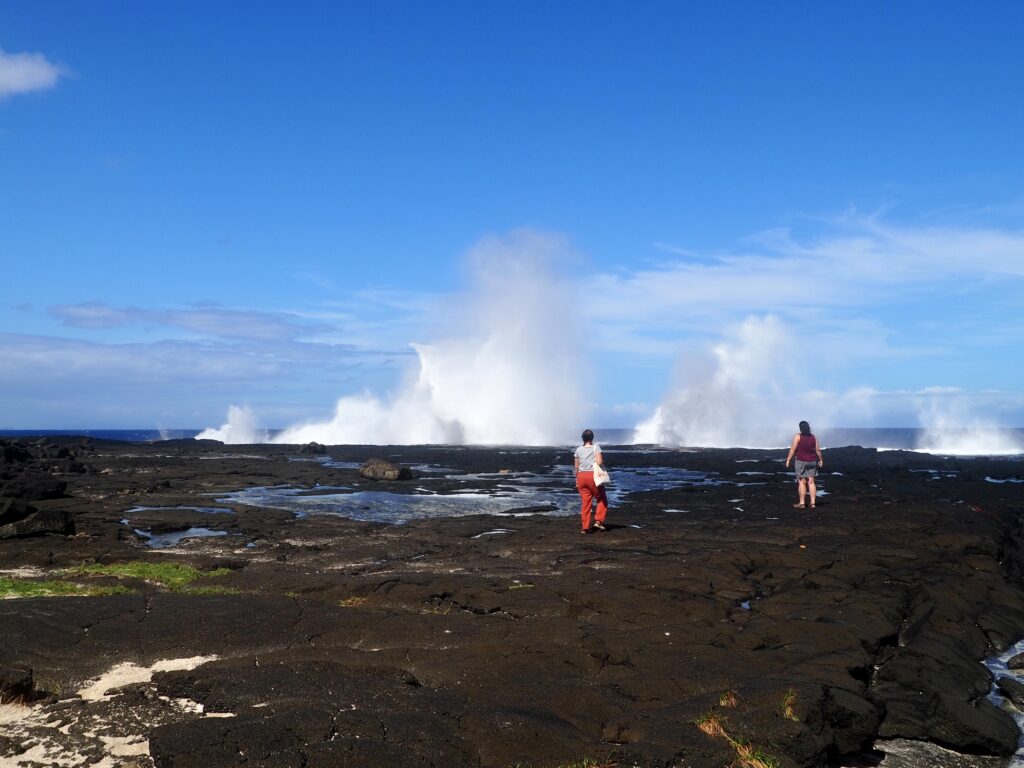

Vaisala Beach
Finally, we arrived at the western end of Savai’i and our accommodation at Vaisala for the next two nights. The hotel is built right alongside the beach, but the land on either side is private and fenced off, so we couldn’t really leave the hotel property on our own. Our rooms were simple, with air conditioning but no hot water or internet. The real star though was our balconies, which all overlooked the beach! The water was sparkling blue in the sun and crystal clear, lapping gently against the soft sand.
We immediately headed down there, since we had a little time before dinner. We only saw a handful of other guests during our stay here, so it really felt like our own private beach a lot of the time. There was a coral reef running along most of the beach, so you can only enter at one end to get past it (or risk swimming over it and scraping yourself). The water was lovely and warm, so we stayed in for ages without getting cold, swimming and floating. A few group members had their own snorkels (there weren’t any to rent at the hotel) and reported plenty of tropical fish in the reef. We caught a bit of a sunset, though it was obscured by clouds, before dragging ourselves away for dinner.




Day Four – Falealupo Peninsula
Moso’s Footprint
We were off to explore more of Savai’i today, mainly its westernmost point around the Falealupo peninsula. While not a huge area of land, the roads here are narrow, bumpy and overgrown in places, so it was slow going much of the time. Our leader explained that the area is connected to many Samoan legends, starting with Moso’s footprint. Moso was a giant who left this footprint when he stepped from here over to Fiji. The footprint is basically in someone’s front yard, their colourful fale sitting just behind it. The depression lies in black volcanic basalt and is about 2m long, so definitely must belong to a giant! It’s just a quick stop, but was a fun story to hear about.
Seeti Beach
Reaching the coast, we stopped for an hour or so at the idyllic Seeti beach, which looked straight out of a postcard. Perfect white sand, crystal clear turquoise water, and palm trees swaying overhead. We had it entirely to ourselves as well! At the end of the beach, there’s a different type of tree which seemed to swirl with movement as we approached. This is the butterfly tree, named for the dozens of insects fluttering amongst its branches. Not something I expected to find on a beach anyway!
After checking out the butterflies, I headed into the water for a swim in the delightfully warm water. Honestly, everywhere we swam this week in Samoa had pretty temperate water, never that cold! The water was shallow and we had to be careful of rocks in places, but it was lovely to just lounge around. While drying off after, I watched tiny white crabs scuttling over the sand and even glimpsed a school of flying fish at the right moment as they leapt from the water! Seeti is certainly up there was one of the prettiest beaches I’ve been to.

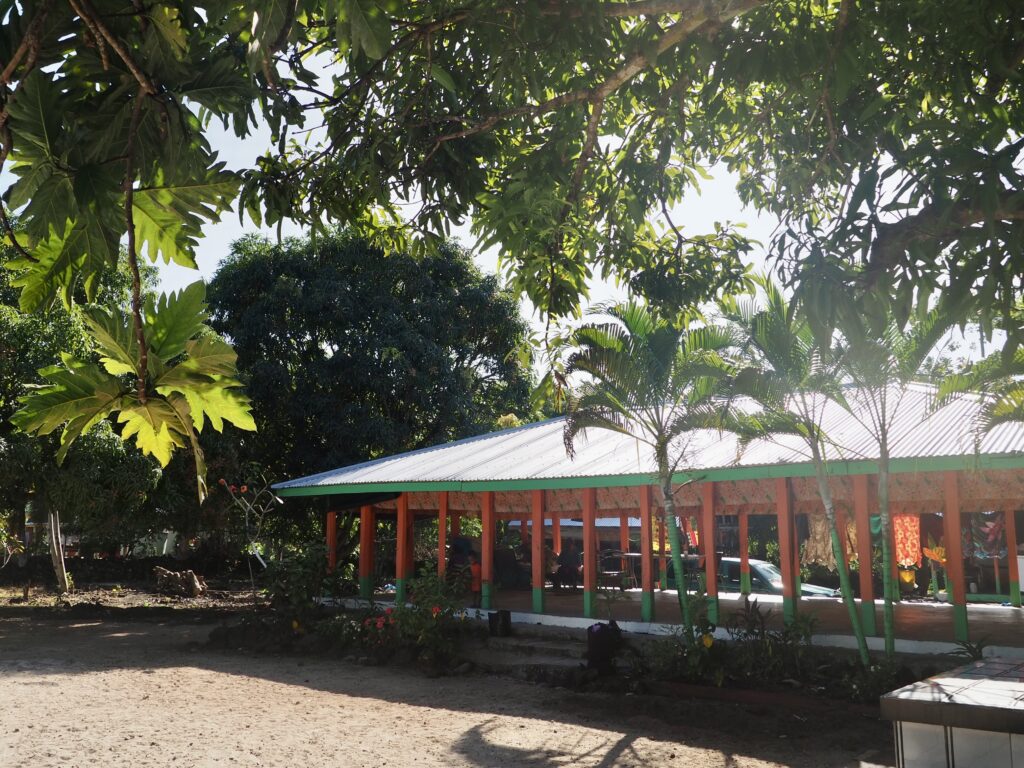




Passage of the Afterlife
Further around the coastline at Cape Mulinuu, we stopped at another sandy area, lined with black volcanic rocks. Our leader put on her lavalava as a mark of respect for this special location for Samoans. She led us up on the black rocks, here at the westernmost point of the country. A gap in the rocks was revealed, which is the Passage of the Afterlife or Fafa o Sauali’i. A little like Cape Reinga back in New Zealand, this is the path that spirits take as they depart Samoa and journey to the afterlife. It’s a remote location, far from even the nearest villages, and a peaceful sacred place for Samoans.
In the trees behind the beach, we also went to see the Giant’s Cave and a well called Vaisuatoto. It’s a short walk through the forest to a pair of holes deep in the ground. They don’t look like much on their own, but our leader told us the associated legends, which make it all much more interesting! The other main sight here is the Star Mound, but the path uphill is very overgrown and rocky. Our leader wasn’t comfortable taking us up this one. On the way back, we stopped at a beachside cafe for lunch as well.





Umu Demonstration & Fia Fia Night
Back at the hotel, we had a little beach time before we went up to the outdoor kitchen behind the reception building. The staff had already started preparing dinner, using traditional Samoan dishes and cooking methods. They were preparing breadfruit, taro, freshly caught fish and plenty of coconut cream in amongst it all. We got to see a coconut demonstration, including how they open it up, grate the meat and then squeeze it to get the cream out. Then everything was cooked in the umu, which is a traditional underground oven. It’s created by setting a fire to heat up rocks. Once they’re hot enough, the food is buried amongst them and the whole thing is covered with leaves while it cooks. Samoans usually do this on Sundays after church or special occasions.
We had a bit of time while everything cooked, so we went for a short walk around the property, enjoying the colours of the sunset! Then it was our fia fia night, with dinner served family style, all the dishes laid out along our table to serve ourselves from. The main proteins here are chicken and fish, of which I tried a little of both (though I eat mainly vegetarian). The coconut flavours were lovely! Samoan cuisine is mainly based on what they can cultivate here, and perhaps isn’t the most varied, but it was great to get to sample a typical meal. While we ate, the hotel staff had pulled out their instruments to play music and songs, both in English and Samoan, which we stuck around to listen to after eating as well.





Day Five – Savai’i North Coast
Turtle Reserve
We checked out of the hotel this morning and began our journey back across Savai’i to the ferry again. This time we were following the north coast, with different sights to stop at. First up was a turtle reserve. This wasn’t actually on our itinerary, but a couple of group members had asked about seeing or swimming with turtles. The turtles here have been rescued and are healing before being released again. However, I didn’t agree with letting visitors jump in the pool beside them, or feeding them papaya constantly. I think this is why it had been taken off the itinerary previously. They were beautiful creatures to see, but I’d like the reserve to be run better.
Saleaula Lava Field
Continuing on, our main attraction of the day was the Saleaula lava field. The volcano erupted near here almost a century ago, decimating the village, and the ground is still covered in thick, hardened black lava that we walked on top of. Yet a couple of things survived the eruption! The first was the Virgin’s Grave, where a religious woman was buried. The guide explained that she was one of the only proper Christians in the village at the time, with other villagers not observing the faith fully, so she was something like a nun. She died of illness before the eruption and the lava flowed around her grave, leaving it visible in a hole in the black rock. It was pretty crazy how perfectly the grave was avoided!
The other site was just as religious, the remnants of a church. While the lava destroyed the interior and the roof is long gone, the stone walls remain standing. You can clearly tell from the shape that it was a church still! Again, quite surreal to walk around inside the walls with all the lava underfoot. Samoa is a very Christian country, so it’s pretty significant to them for these places to be the only ones to survive the eruption.




Sapapali’i
We made one more quick stop at the village of Sapapali’i. Next to the road is a small monument to John Williams, a British missionary who came to Samoa in 1830. They erected the monument in 1930 to celebrate 100 years of Christianity in Samoa. Coming up close to 200 years now! Christianity took such a firm hold here and it was interesting to see missionaries being commemorated and respected here, in comparison to other colonial countries which had far more negative experiences. Travel is all about learning and understanding other people and places after all.
From there, we returned to the Salelologa ferry terminal, where we tucked into our takeaway lunches in the van. The schedule had been changed so we were on a later ferry than normal for this itinerary. Once we arrived back on Upolu, it was a long drive all the way to Lalomanu on the other end of the island. It was almost dark when we got off the ferry so there wasn’t much to see on the drive. We all went straight to bed on arrival!

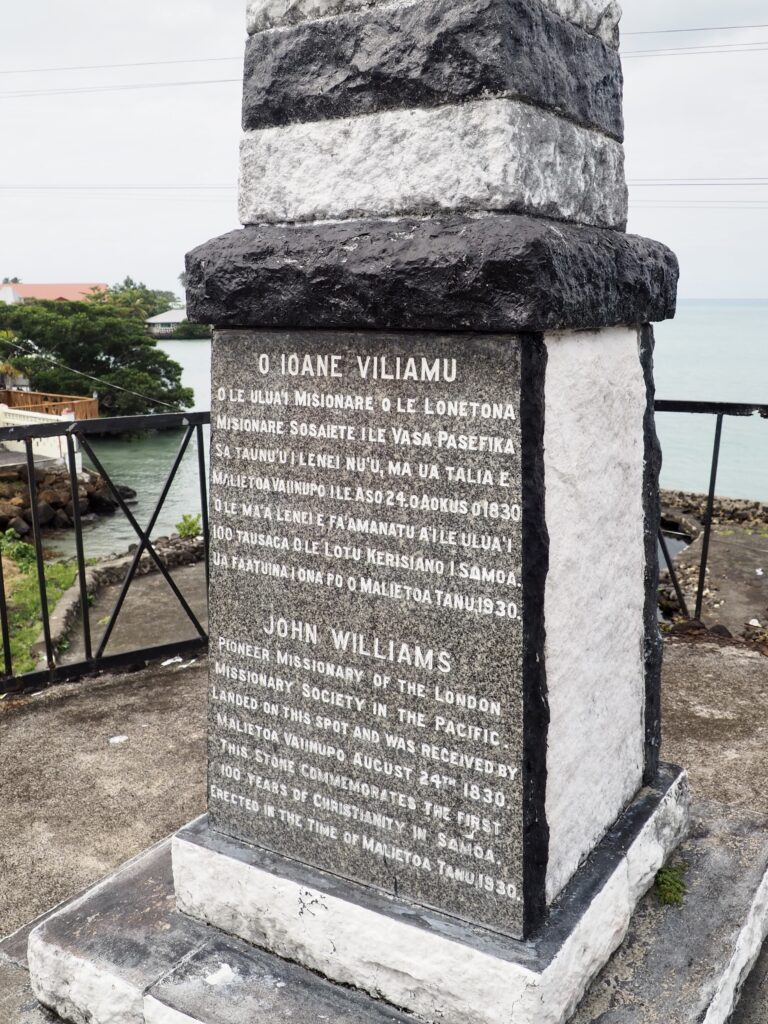

Day Six – Vavau Village
Ava Welcoming Ceremony & Dance
The next morning I awoke to a lovely beach view, dotted with fales, from my colourful bungalow perched up the hillside. I hadn’t really appreciated it in the dark last night! After breakfast we drove down the road to the nearby Vavau village. Specifically, to the beach where we would be meeting some of the local villagers. Most beaches in Samoa belong to a local village, so you normally have to pay them a small entrance fee. We all wore lavalavas or long skirts, as you have to cover your knees in respect. Then we sat in a row of chairs, while the villagers were cross-legged on mats on the ground for the ‘ava welcoming ceremony.
They conducted the ceremony in Samoan, so I have no idea what they were saying. The village chief and a few other elders spoke, while a younger man dressed in traditional garb performed rituals with their staffs. He also served us the kava from a coconut shell, a ceremonial drink made from a plant root. Variations of it are found in other Pacific islands too, including Fiji and Vanuatu.
After the welcoming ceremony, we moved to a long table for the lunch they had prepared for us. While we ate, the village women came out to entertain with traditional songs and dances. The moves looked simple at first, but were elegant and intricate, and much harder when they made us try! Once we’d eaten, they pulled our group up to dance with them. We mimicked their moves at first, before everyone dissolved into a casual freestyle. It was a nice way to break the ice too!

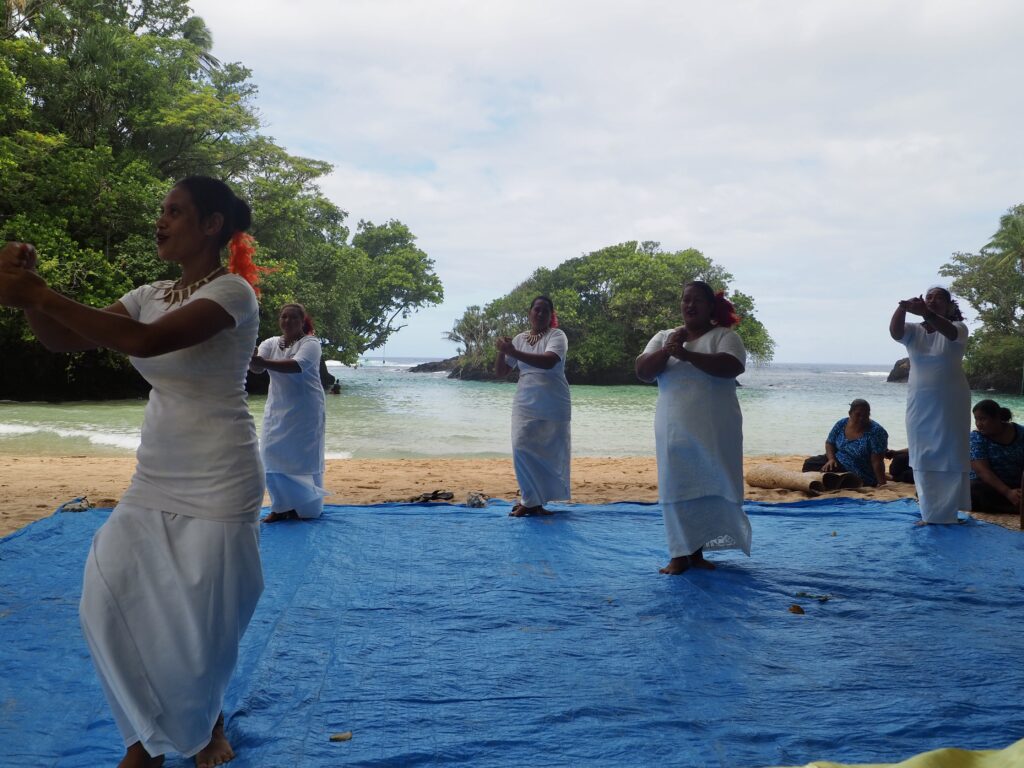

Vavau Beach
The villagers dispersed after the dancing was over but we could stay to enjoy the beach a little longer. It was a beautiful spot, a sandy cove lined with palm trees and a couple of densely tree-clad islands just off the shore. The weather had been mixed that morning, pockets of sunshine between light rain showers. The sunny moments lit up the sea in a brilliant turquoise blue! We seized a dry moment to jump in the water, drifting around in the cove. The water is rougher beyond the islands, so they have ropes strung up to act as a boundary point not to pass.
The largest island divides the cove from a longer stretch of beach, which we also ventured across to. A couple of us got our exercise in by swimming the length of the beach, then walking back along the sand. It had gotten a bit cool and drizzly by then, so we dried off and left Vavau, heading back to our accommodation.
Rainy Afternoon
We were staying in bungalows right next to the beach near Lalomanu, so the plan was a beachy afternoon, but the weather had other plans. It began to pour with rain, much heavier than that morning, so a few of us sat under the cover of the bar-restaurant, watching the rain through the open sides of the structure. We grabbed some drinks and playing cards and spent the afternoon chatting away. While it was a shame to not be able to go out (there aren’t really any other optional activities nearby either), it was nice to not feel guilty about doing nothing. I’m often so busy trying to see as much as possible when travelling, that I don’t take enough time to rest!
We had dinner included there as well. All of the guests go to dinner at the same time, seated at long tables with dish after dish brought out from which to help yourself. They set up a karaoke machine after (not for me, I can’t sing at all!) and we hung around for a while enjoying the music.



Day Seven – Upolu South Coast
Sopo’aga Falls
For our last full day of our week in Samoa, we headed out for a half-day of activities in the southern part of Upolu. First up was another waterfall, Sopo’aga Falls. This is a pretty tall waterfall, tumbling down into a deep, lush, green valley. There probably is a track you could hike down to the river and plunge pool, but we weren’t doing that or going for a swim at this one. Instead, we stood at the top of the valley admiring the view from above. It was a stunning tropical jungle scene, so much of the forest unknown and untouched, as is true across much of Samoa.
The viewpoint was next to a small garden full of different trees and plants, which our leader explained to us. She said Samoans only grow plants they can eat or use somehow, so everything here has a purpose. Our driver also did another coconut demonstration for us, similar to the one back at Vaisala. Although he grated the meat using a more traditional tool this time. And none of us were passing up the opportunity to drink more coconut water!



To-Sua Ocean Trench
Continuing on, we headed to one of Samoa’s most famous natural wonders, the To-Sua Ocean Trench. We arrived at a grassy field atop a high coastal cliff. I stopped to admire and grab photos of the view here, which was pretty incredible! In the centre of the field, a huge hole opens up in the ground, revealing the bright turquoise water inside the trench below.
This is saltwater, flowing in from an underground tunnel connected to the sea, and there’s even a tide within the pool, tugging you across it from side to side. We descended the ladder into the middle, which was a little slippery and quite high, so slightly nerve-racking for me! A large group of teenagers arrived not long after us and used the ladder to jump off into the water. It did make it a bit difficult to exit later, waiting for a gap to climb past them. Anyway, inside the trench, we swam in the pool for ages, exploring the corners where fish were lurking.
You can swim through a short tunnel to a second opening to the sky. However the water ends before you get there and the shore is thick with vegetation, so we didn’t climb out. It’s quite a deep pool, with only a few rocks where you can touch the bottom and a couple of ropes strung across the surface. It was pretty busy, but we still lingered in the water until it was time to leave, enjoying this unique, beautiful swimming spot!




Lalomanu Beach
Back at Lalomanu again for the afternoon, we had lunch at the restaurant first. The sun was out today, so we headed straight to the beach after we’d eaten. Lalomanu is recognisable for its island offshore, Nu’utele, which was once a leper colony and is now uninhabited. We wandered along the beach a ways, past the fales and palm trees, taking a few photos as we went.
Then we picked our spot and jumped straight into the water, just as clear and warm as the other beaches we’d swam at. It’s sandy by the shore, but there’s a reef a bit further out for anyone wanting to snorkel. Although there was no snorkelling gear available to rent or borrow, so you would have to bring your own. I was content just floating and swimming instead. We relaxed here for several hours, enjoying a restful final afternoon, until it began to get dark.



Fa’ataupati Show
After changing for dinner, we headed back to the restaurant for another family-style sharing meal. Since it was the last night of our group tour, we had all dressed up a bit. After the meal, they rearranged the seats for the evening show, a fa’ataupati or ‘slap dance’ performance. The group emerged in their traditional clothing, lavalavas for the men and two-piece patterned blue puletasi for the women, with flowers in their hair.
The ‘slap dance’ is traditionally a male performance, the boys slapping their bodies in fast, complicated, breathtaking pattern! The women performed other traditional dances, similar to what we’d seen at Vavau the day before. And they had a few dances where the whole group alternated or performed together. Everything was very fast and high-energy, so there was a real buzz and excitement in the air! Our driver was a Polynesian dancer as well, who has travelled all over the world and knows dances from various countries, so he did a quick solo performance as h’ed promised earlier that week as well. It was all amazing and so much fun to watch!
After the performance, they put on more music for everyone to get up for a dance. Although it was extremely hot and sticky that night, so I didn’t last too long! We also gathered up the group once more to say our farewells, since our leader had to depart later that night. She gifted us with lavalavas from the accommodation to take home too. The next morning, our same driver transported me and a few others (the rest were staying an extra night) back across the island to the airport, where my week in Samoa came to an end.




A Week in Samoa
Samoa is a beautiful country, so much of it still rugged and untouched. It’s also still a developing country, so I would recommend people be patient when travelling there and do your research. We had no internet or hot water for most of the week! But for me, that was a small price to pay to visit somewhere still fairly remote and off-the-beaten-track. I’m glad we got to travel around and see so much of both islands, rather than staying in the same place for the whole week. I felt like I learned so much about the culture and history from our leader, and got to see some truly stunning natural scenery. Even with a few rainy days, it was a welcome break from New Zealand winter, and now I can’t wait for my next Pacific island adventure soon!

A Week in Northland | New Zealand

Highlights of Fiji
You May Also Like

Turnhouse Hill, Pentlands | Hiking Edinburgh
20 September 2019
Weekend Trip to Toronto | Canada
12 December 2022